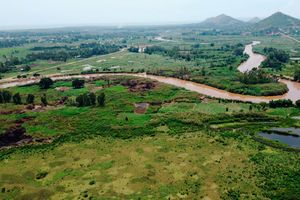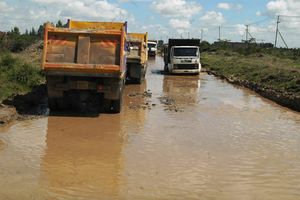Ignore El Nino warning at your peril: Weatherman

Kenya Meterological Department Director Dr David Gikunju explains how the Stevenson screen works during an interview at the KMD head office in Nairobi on November 6, 2023.
The Kenya Meteorological Department (KMD) on Monday (November 6) reiterated that the country will experience El Nino rains, and this month will be the peak period.
This comes a few weeks after President William Ruto downscaled the weather phenomenon, saying that he had been told that the intensity of the rainfall will not be as had been predicted.
The Presidsent, however, did not say who shared the information with him, prompting him to make the public statement.
“You recently heard that our country is going to experience El Nino, but who is God, have you heard that those people say that we will not have it (El Nino) but there will be just heavy rainfall,” he said during a church event on October 22.
But KMD Director Dr David Gikungu set the record straight, saying the department issued a forecast on the possibility of an El Nino phenomenon while outlining characteristics of the short rains this year. The department has not changed its position.
Reacting to the President’s comments, Mr Gikungu said that whatever the Head of State said did not negate the fact that there will be heavy rainfall.
“Whether there is El Niño or not, rainfall is what we are reacting to,” he said.
“As the director, I did my part in terms of preparedness for El Niño. We have issued forecasts, we have given information in English and Swahili. We have attended meetings on various levels and we even have County Directors of Meteorology who downscale the forecast to their people by providing information to users even in their local language,” he added.
Dr Gikungu said that confusion about El Nino comes about because Kenyans associate the phenomenon solely with rains.
“Sometimes we may have other features on El Niño but if the temperatures are not in agreement, we may not necessarily have an increase in rainfall,” he said.
El Niño conditions
“Our rainfall season is enhanced by the presence of El Niño conditions as well as the Indian Ocean Dipole that is positive and has been so for quite some time now. Even this morning, I looked at the pictures and it is still showing positive, this is why we have and should expect heavy rainfall in some parts of the country,” explained Dr Gikungu.
He said that this year’s El Nino phenomenon will last during the entire short rains season which is normally in October to December, but there is a likelihood that it may extend to January 2024.
Dr Gikungu stated that El Nino conditions are experienced differently, and in a varied way, depending on the region.
While every year there has to be short rains or long rains, he added, there could be a system reversal that causes either excess rainfall, or lack of it.
“There will be places where there will be a reduction in rainfall. What we are receiving is widespread rainfall and that will continue,” he said.
The director said that while scientists make a comparison of different El Nino phenomena based on the intensity of the rainfall, every event has its own characteristics and it will always vary.
Safer places
“When we are making forecasts to make decisions on what to disseminate we look at what has happened in the past. We also look at the similarities that compared best with what is ongoing, so that it helps one to explain the features that are observed,” he added
Dr Gikungu urged Kenyans living in vulnerable areas to take precautions from the Meteorological Department seriously and find alternative and safer places to stay during the rains.
“What comes with excess rainfall is distraction. When there is less rainfall, there is usually moisture in the ground and that increases with time causing mudslides and landslides.
“There are places that are fairly flat, the rainfall tends to result in flooding, and therefore displacement of people and loss of livestock. Sometimes there will be increased levels of water along the coastline which can also lead to displacement of part of the population that is found there,” he added.
Dr Gikungu asked Kenyans to take the information that comes from social media with a pinch of salt and on matters of weather, the KMD should be the source.





